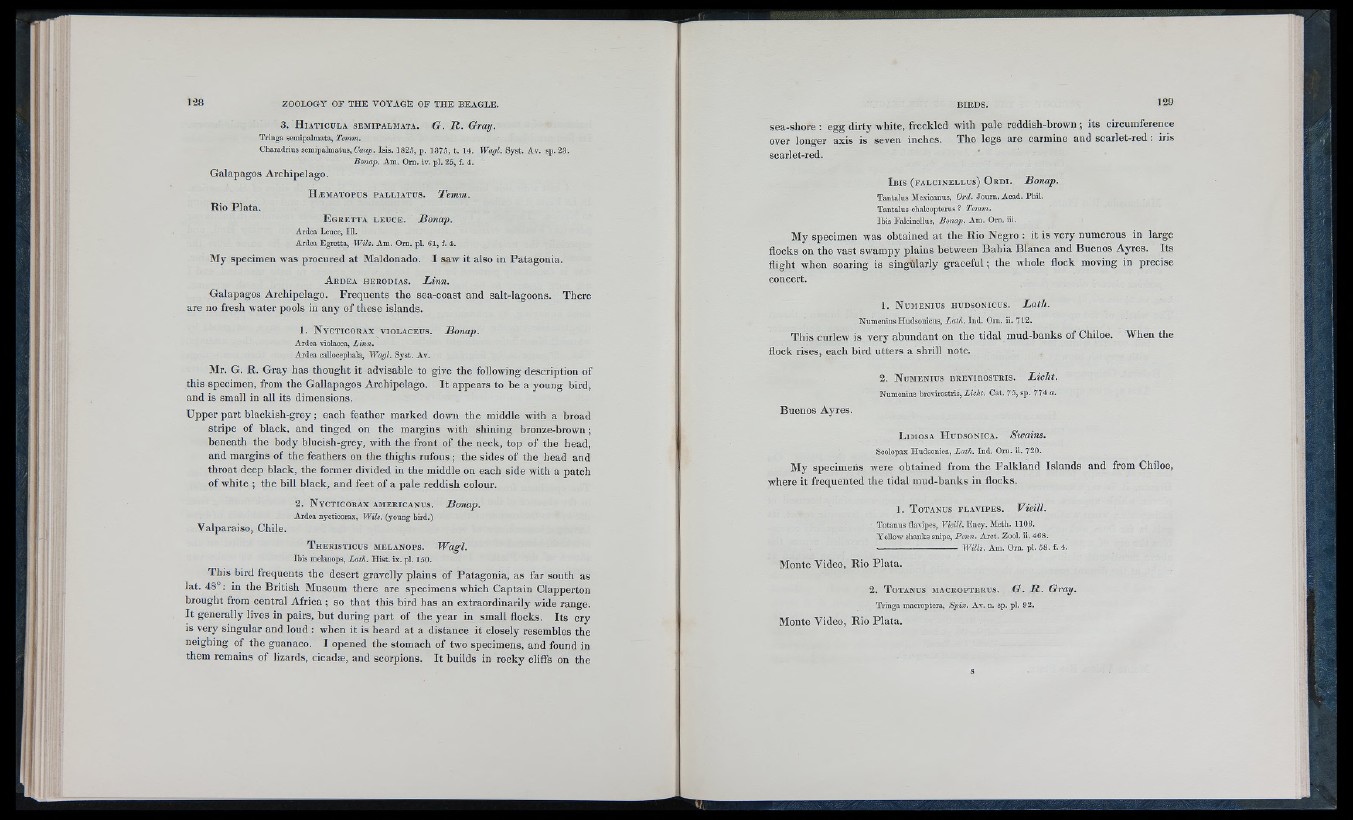
3 . H ia t i c u l a s e m i p a l m a t a . G. R . Gray.
Tringa semipalmata, Temm.
Charaiirius semipalm.atus, Caiip. Isis. 1825, p. 1375, t. 14. Wagl. Syst. Av. sp. 23.
Bonap. Am. Orn. iv. pl. 25, f. 4.
Galapagos Archipelago.
H iE m a t o p u s p a l l i a t u s . Temm.
Rio Plata.
E g r e t t a l e u c e . Bonap.
Ardca Leuce, 111.
Ardea Egretta, TV«7s. Am. Orn. pl. 61, f. 4.
My specimen was procured at Maldonado. I saw it also in Patagonia.
A r d e a h e r o d ia s . Linn.
Galapagos Archipelago. Frequents the sea-coast and salt-lagoons. There
are no fresh water pools in any of these islands.
J . N y c t ic o r a x v io l a c e u s . Bonap.
Ardea violacea, Lin n .
Ardea callocephala, Wagl. Syst. Av.
Mr. G. R. Gray has thought it advisable to give the following description of
this specimen, from the Gallapagos Archipelago. It appears to be a young bird,
and is small in all its dimensions.
Upper part blackish-grey; each feather marked down the middle with a broad
stripe of black, and tinged on the margins with shining bronze-brown;
beneath the body blueish-grey, with the front of the neck, top of the head,
and margins of the feathers on the thighs rufous; the sides of the head and
throat deep black, the former divided in the middle on each side with a patch
of white ; the hill black, and feet of a pale reddish colour.
Valparaiso, Chile.
2 . N y c t ic o r a x a m e r i c a n u s .
Ardea nycticorax, (young bird.)
Bonap.
T h e r i s t i c u s m e l a n o p s . Wagl.
Ibis melanops. Lath. Hist. ix. pl. 150.
This bird frequents the desert gravelly plains of Patagonia, as far south as
lat. 48°: in the British Museum there are specimens which Captain Clapperton
brought from central Africa ; so that this bird has an extraordinarily wide range.
It generally lives in pairs, but during part of the year in small flocks. Its cry
IS very singular and loud : when it is heard at a distance it closely resembles the
neighing of the guanaco. I opened the stomach of two specimens, and found in
them remains of lizards, cicadae, and scorpions. It builds in rocky cliffs on the
sea-shore : egg dirty white, freckled with pale reddish-brown ; its circumference
over longer axis is seven inches. The legs are carmine and scarlet-red : iris
scarlet-red.
I b i s ( f a l c i n e l l u s ) O r d ì . Bonap.
Tantalus Mexicanus, Ord. Joum. Acad. Phil.
Tantalus clialcopterus ? Temm.
Ibis Falcinellus, Bonap. Am. Orn. iii.
My specimen was obtained at the Rio Negro : it is very numerous in large
flocks on the vast swampy plains between Bahia Blanca and Buenos Ayres. Its
flight when soaring is singularly graceful; the whole flock moving in precise
concert.
1 . N u m e n i u s h u d s o n ic u s . Lath.
NumeniusHudsonicus, Lath. Ind. Orn. ii. 712.
This curlew is very abundant on the tidal mud-banks of Chiloe. When the
flock rises, each bird utters a shrill note.
2 . N u m e n iu s b r e v ir o s t r i s . Licht.
Numenius breiurostris, Xtc/ii. Cat. 75, sp. 774 o.
Buenos Ayres.
L im o s a H u d s o n i c a . Stvains.
Scolopax Hudsonica, Lath. Ind. Orn. ii. 720.
My specimens were obtained from the Falkland Islands and from Chiloe,
where it frequented the tidal mud-banks in flocks.
1 . T o t a n u s f l a v i p e s . Vieill.
Totanus flavipes, Vidll. Ency. Meth. 1106.
Yellow shanks snipe, Penn. Arct. Zool. ii. 468.
------------------------------- Wills. Am. Orn. pl. 58. f. 4.
Monte Video, Rio Plata.
2 . T o t a n u s m a c r o p t e r u s . G .R . Gray.
Tringa macroptera, Spix. Av. n. sp. pl. 92.
Monte Video, Rio Plata.